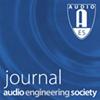虚拟环境中的声音交互(SIVE)工具包
IF 1.1
4区 工程技术
Q3 ACOUSTICS
引用次数: 0
摘要
本文介绍了虚拟环境中的声音交互(SIVE)工具包,这是一个用于使用物理模型构建乐器的虚拟现实(VR)环境。该工具包的音频引擎基于时域有限差分(FDTD)方法,并以模块化的方式工作。作者展示了如何构建工具包以及如何将其导入Unity以创建VR乐器,并讨论了未来的发展和可能的应用。本文章由计算机程序翻译,如有差异,请以英文原文为准。
The Sonic Interactions in Virtual Environments (SIVE) Toolkit
In this paper, the Sonic Interactions in Virtual Environments (SIVE) toolkit, a virtual reality (VR) environment for building musical instruments using physical models, is presented. The audio engine of the toolkit is based on finite-difference time-domain (FDTD) methods and works in a modular fashion. The authors show how the toolkit is built and how it can be imported in Unity to create VR musical instruments, and future developments and possible applications are discussed.
求助全文
通过发布文献求助,成功后即可免费获取论文全文。
去求助
来源期刊

Journal of the Audio Engineering Society
工程技术-工程:综合
CiteScore
3.50
自引率
14.30%
发文量
53
审稿时长
1 months
期刊介绍:
The Journal of the Audio Engineering Society — the official publication of the AES — is the only peer-reviewed journal devoted exclusively to audio technology. Published 10 times each year, it is available to all AES members and subscribers.
The Journal contains state-of-the-art technical papers and engineering reports; feature articles covering timely topics; pre and post reports of AES conventions and other society activities; news from AES sections around the world; Standards and Education Committee work; membership news, patents, new products, and newsworthy developments in the field of audio.
 求助内容:
求助内容: 应助结果提醒方式:
应助结果提醒方式:


